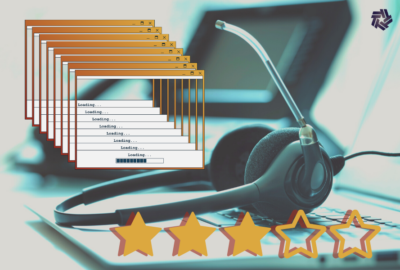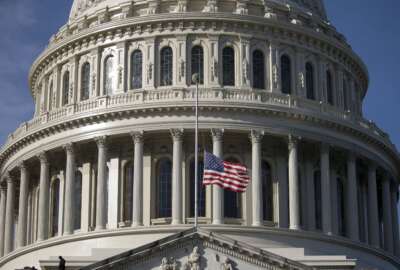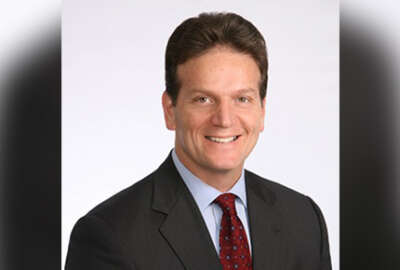
An old hand at federal budgeting analyzes what the 2023 proposal really says
Nearly every agency would see more money in 2023 under the Biden administration's top line request, but it also shows the increasing pressure of the so-called...
Best listening experience is on Chrome, Firefox or Safari. Subscribe to Federal Drive’s daily audio interviews on Apple Podcasts or PodcastOne
Nearly every agency would see more money in 2023 under the Biden administration’s top line request, but it also shows the increasing pressure of the so-called discretionary spending, as mandatory spending expands. As part of our ongoing analysis of the skinny budget, Federal Drive with Tom Temin turns to former federal budget official, now the managing director of Grant Thornton public sector, Doug Criscitello.
Interview transcript:
Tom Temin: Doug, good to have you back.
Doug Criscitello: Hi, Tom. Great to be here.
Tom Temin: So what are your observations on this? 1.5 trillion, everything seems to be up, up and up.
Doug Criscitello: Yeah. So in the near term, there is a big focus on increasing spending both domestically and on our defense and security budgets with an eye toward trying to limit the increases in our annual budget deficits by also proposing revenue increases primarily by levying taxes on higher wealth individuals and corporations. But there is a lot included on the budget around a moniker, a new slogan, if you will, called Building a Better America.
Tom Temin: Yeah. And so what are some of the elements? And what are the some of the agencies that would be pulled into that effort?
Doug Criscitello: So a broad range of issues are addressed from climate change to pandemic preparedness to quite a few items that last year were characterized as build back better, right doing things like cutting costs for health care and childcare, making housing and college more affordable. And the budget also builds on some of the legislative successes from 2021, including the bipartisan infrastructure law, and also the American Rescue Plan Act, which provided a host of pandemic and economic aid to, you know, to get us back on track.
Tom Temin: Yeah. And I guess the big question, then, you know, how accurate are their assumptions? Because you’ve got a lot of dynamic forces at work in a proposal like this. When you increase taxes, there’s always concomitant effects elsewhere in the economy. And then there’s the factor of inflation, which is up and down, up right now. And from your experience in judging the dynamics of budgets, does this all look like it could work in terms of the inflation that’s ahead and the effect of tax increases as they spread throughout the economy, and different sectors adjust.
Doug Criscitello: It’s a complex analysis to determine the impact that this particular mix of fiscal policies will have on our economy. And the Congress and president and deliberating the budget can only go so far in fighting inflation. I mean, that is a consistent theme that we’re hearing from both sides, right. We need to fight inflation, it’s on the rise. And understandably, right, several things have happened. There’s a war in Europe now. So higher fuel prices, and hopefully a receding pandemic. And we have all this pent-up demand for goods and services in the aftermath of a series of huge U.S. government fiscal responses and the world order seems to just be readjusting right now. So what can the federal government do to fight inflation? Well, fiscal policy is just one part of it. And I think it’s actually a relatively modest part. The Federal Reserve Board is responsible for monetary policy, and they have a specific mandate to keep both inflation and unemployment low. And without going into a bunch of detail on how monetary policy is conducted, it’s important to understand that the fed’s action have a profound influence on economic activity across the country, and ultimately impacts inflation much more significantly than anything that can be done on the fiscal side of the ledger.
Tom Temin: We’re speaking with Doug Criscitello, managing director of Grant Thornton public sector. And especially the Fed has an effect on interest rates, which then eventually backs up to Treasury rates, which then also backs up to what the country is paying for its debt service. And as that rises, then that’s sort of a new growth element relative to the the non-discretionary and the discretionary spending.
Doug Criscitello: Right. And, you know, at the risk of sounding like Chicken Little here, I really am a broken record on this topic, because if you look at long-term expectations about interest payments, it just becomes such a significant portion of the budget As we move to future decades. The Congressional Budget Office did a fascinating report last year, where they pointed out that interest payments alone would total about $60 trillion over the next 30 years, and would take up half of all federal revenues by 2050. That’s astounding. So, under current policies, interest payments are expected to rise to a level where they will surpass all discretionary spending by 2043. And be an even larger budget item than Medicare or Social Security during that decade and the 2040s Really, something we need to be paying serious attention to.
Tom Temin: Right, so that another billion or few for agriculture, IT or for the cybersecurity and infrastructure security agency, is kind of a small potatoes matter, then, in that context.
Doug Criscitello: Yeah, it really is. And discretionary spending has become such a small portion of the budget, really the work that the appropriation committees do, the portion of the budget that’s on auto-pilot is just incredible. You know, if we look back and the trends are unmistakable, right, over the last 50 years, mandatory spending has steadily increased as a share of the economy. Not looking at it in dollar terms. And discretionary spending is actually falling quite a bit. It’s about half its level now than it was 50 years ago. And mandatory spending is more than two and almost three times greater. So that’s the dynamic that’s playing out. And as I said, interest is slated to grow going forward. Which, you know, that might be okay, if revenues were keeping pace, but they’re not. So this is that structural budgetary imbalance that we’ve been talking about through the years, you know, we’re just not on a sustainable path.
Tom Temin: In the meantime, though, we do have that discretionary portion of slightly north of 1.5 trillion. And just give us the top line on what the priorities are, that federal agencies actually can have some control over, because the deficits in the sustainability trend are kind of beyond their paygrade.
Doug Criscitello: Yeah, it’s still important, right? We’re still here. You’re absolutely right. Anything that totals well, over a trillion dollars is very, very significant. And discretionary spending is approaching, I think before long will be will be $2 trillion. So it’s a huge amount of money. And the Biden administration is directing it to its policy priorities, right. It’s not surprising, more money going to defense, education, public health, health care, very smartly, pandemic preparedness. So, I think it’s interesting that, some of the reports that I’ve read on the budget, characterize it as a pretty significant pivot from last year. I think it’s a bit of a pivot. I think it reflects some of the political realities going into the midterm elections. But it’s quite consistent with what was proposed last year. Right, a real commitment to sort of building up the working class, imposing additional taxes on the wealthiest and corporations, doing things like addressing climate change, strengthening our defense. So yeah, it’s easy to talk about the near term. It’s unmistakable how there are near-term policy priorities, but a failure to address the long term. And look, the Biden administration isn’t alone in doing this. I haven’t seen a single budget this century that addresses these long term issues. At least on the mandatory side of the budget.
Tom Temin: Right. And nor has Congress for that matter, either.
Doug Criscitello: I mean, there was a serious run at it during the Obama administration. It was very focused on discretionary spending. Right, you’ll remember that I mean, this is sort of where, you know, sequesters came into play in this notion of a bipartisan budgetary agreement, a budget commission would work to develop proposals that the Congress would pass to address discretionary spending over time. Yeah, it didn’t materialize though. And now not too long after we find ourselves in a pandemic where we had to spend five trillion in additional borrowed dollars. And so the trajectory of these problems has steepened if anything in recent years.
Tom Temin: Doug Criscitello is managing director of Grant Thornton public sector. As always, thanks so much.
Doug Criscitello: Thanks, Tom.
Copyright © 2024 Federal News Network. All rights reserved. This website is not intended for users located within the European Economic Area.
Tom Temin is host of the Federal Drive and has been providing insight on federal technology and management issues for more than 30 years.
Follow @tteminWFED





